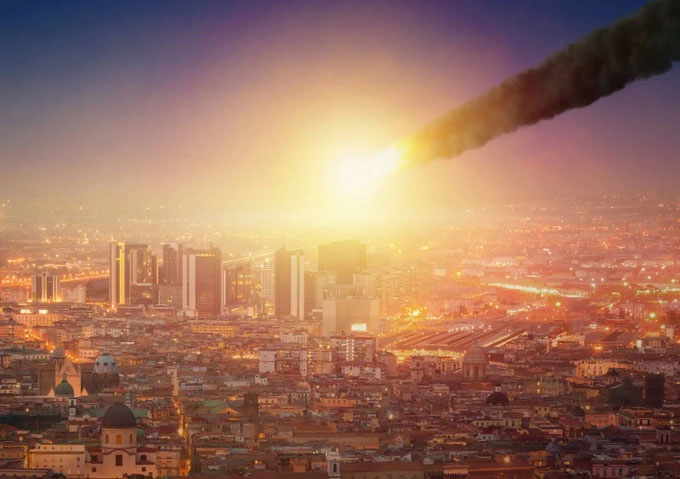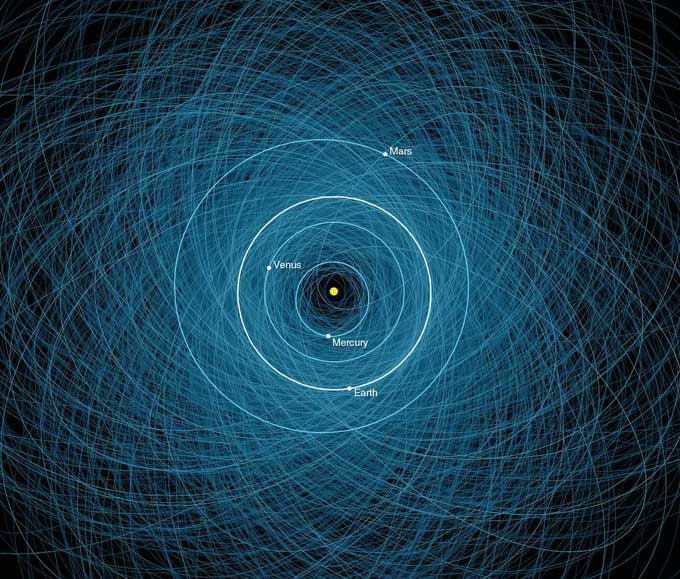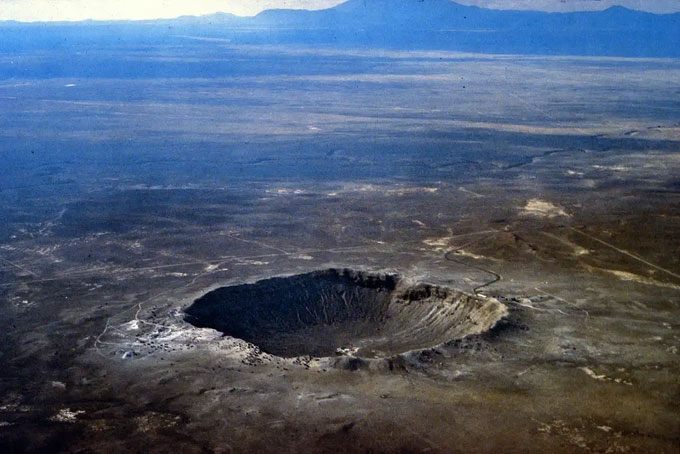In the vast universe, there are millions of celestial bodies like asteroids and comets orbiting the Sun, most of which often collide with Earth. However, because they are too small and are destroyed when passing through the atmosphere, they do not pose any significant danger.
Disasters from Asteroids and Comets
Astronomers consider near-Earth objects a threat if they have a diameter of at least 140 meters and are within approximately 7.4 million kilometers of our planet.
If these celestial bodies were to collide with Earth, it could potentially destroy an entire major city and cause severe devastation in the surrounding area.
In particular, larger asteroids—about 1 km in diameter—could have global effects, even causing mass extinction.

A small asteroid could wipe out an entire city. (Illustration: Igorzh).
In the past, 65 million years ago, Earth faced destruction due to a celestial body with a diameter of 10 km striking an area of what is now the Yucatan Peninsula, wiping out most species of flora and fauna on the planet (including the extinction of the dinosaurs).
In 1908, a 50-meter celestial body exploded over the Podkamennaya Tunguska River in Siberia, flattening over 80 million trees across an area of 2,100 square kilometers.
More recently, in 2013, a 20-meter asteroid exploded in Earth’s atmosphere about 32 km from Chelyabinsk, Russia. The energy released from the explosion was equivalent to approximately 30 atomic bombs dropped on Hiroshima (Japan), injuring over 1,100 people and causing $33 million in damage.

The orbits of thousands of asteroids (in blue) intersect with the orbits of planets (in white), including Earth (Image: NASA).
Scientists predict that on March 11, 2023, Earth could collide with an asteroid approximately 50 meters long.
Although the probability of a large celestial body “attacking” Earth is very low, if it were to happen, it would result in an extremely catastrophic disaster.
The U.S. government recognizes the danger posed by these threats and has tasked NASA with finding and tracking about 90% of near-Earth objects.
Proactive “Interception”
To protect Earth from disasters from outer space, the National Aeronautics and Space Administration (NASA) has developed various scenarios, including the plan to “intercept” asteroids from space.
As expected, the spacecraft named DART successfully collided with the asteroid 11 million km from Earth at 6:14 AM on September 27 (Hanoi time). This is part of the Double Asteroid Redirection Test (DART) plan by NASA. This marks the first planetary defense mission conducted by NASA in this manner.
Using a spacecraft to collide with the binary asteroid Didymos and its moon (currently not a threat to Earth) will alter their trajectory.
To date, NASA has only tracked about 40% of asteroids. Scientists state that in the past, Earth has suffered catastrophic disasters caused by extraterrestrial objects, and such events will certainly occur in the future.
Therefore, the DART mission test could help humanity avoid disasters that have previously occurred on Earth.
As of September 18, NASA has identified approximately 29,724 near-Earth asteroids, with about 10,289 objects having a diameter of 140 meters and 855 asteroids with a diameter of at least 1 km.
Thus, to protect Earth from the risk of collisions with asteroids from space, scientists indicate that early detection is key to prevention.

Crater near Flagstaff, Arizona, created when an asteroid estimated to be about 50 meters in diameter struck Earth approximately 50,000 years ago (Image: USGS).
The DART mission by NASA is a crucial experiment to deflect an asteroid. A camera on the DART spacecraft recorded the process and sent images back to Earth until the moment of impact.
Additionally, on September 11, a small satellite deployed by NASA as part of the mission will be tasked with capturing the moment of the collision and sending data back to Earth for scientists to study.
It is evident that the impact of asteroids on Earth could cause extreme devastation and loss, potentially leading to the literal extinction of humanity.
Therefore, investing in protecting the planet from dangerous celestial objects could provide humanity with a certain level of reassurance while preventing potential disasters.


















































